A bone. A tooth. A sliver of cranium. They got here in baggage, limitless baggage, combined with ash, cash, bullets and shrapnel. Like imperfect tapestries, some held the stays of various individuals. The baggage had been numbered, cataloged and scanned. DNA was extracted. The science was exact, but it surely was laborious to know what occurred, how an individual was killed.
One bag, which held clues to the ultimate seconds of life, unnerved and intrigued Dr. Chen Kugel, head of the Nationwide Institute of Forensic Drugs right here. Since Oct. 7, his employees has been engaged on figuring out the stays of a few of the 1,200 individuals killed by Hamas militants. He has been attempting to know not solely the causes of demise however the underlying hate. Each, he stated, usually lie past one’s creativeness.
He pointed to a pc display.

Dr. Chen Kugel is the top of the Nationwide Institute of Forensic Drugs in Tel Aviv.
“It is a piece of one thing that appears like charcoal,” he stated. “However then you definately see it by a CT scan, and also you see two spines, one among an grownup and one among somebody youthful, possibly 10 or 12 years previous. And two units of ribs. You may see they’re roped round with this metallic wire. These had been individuals who had been hugging each other and burned whereas they had been tied collectively. It may be a mum or dad and a toddler.”
So many baggage — 748 ultimately rely — have handed by the institute. Within the fast days after the killings, the luggage had been greater; the stays, extra definable. However since then, like a stain that fades however by no means goes away, the luggage, and what’s inside them, have grown smaller within the realm the place science and loss intersect.
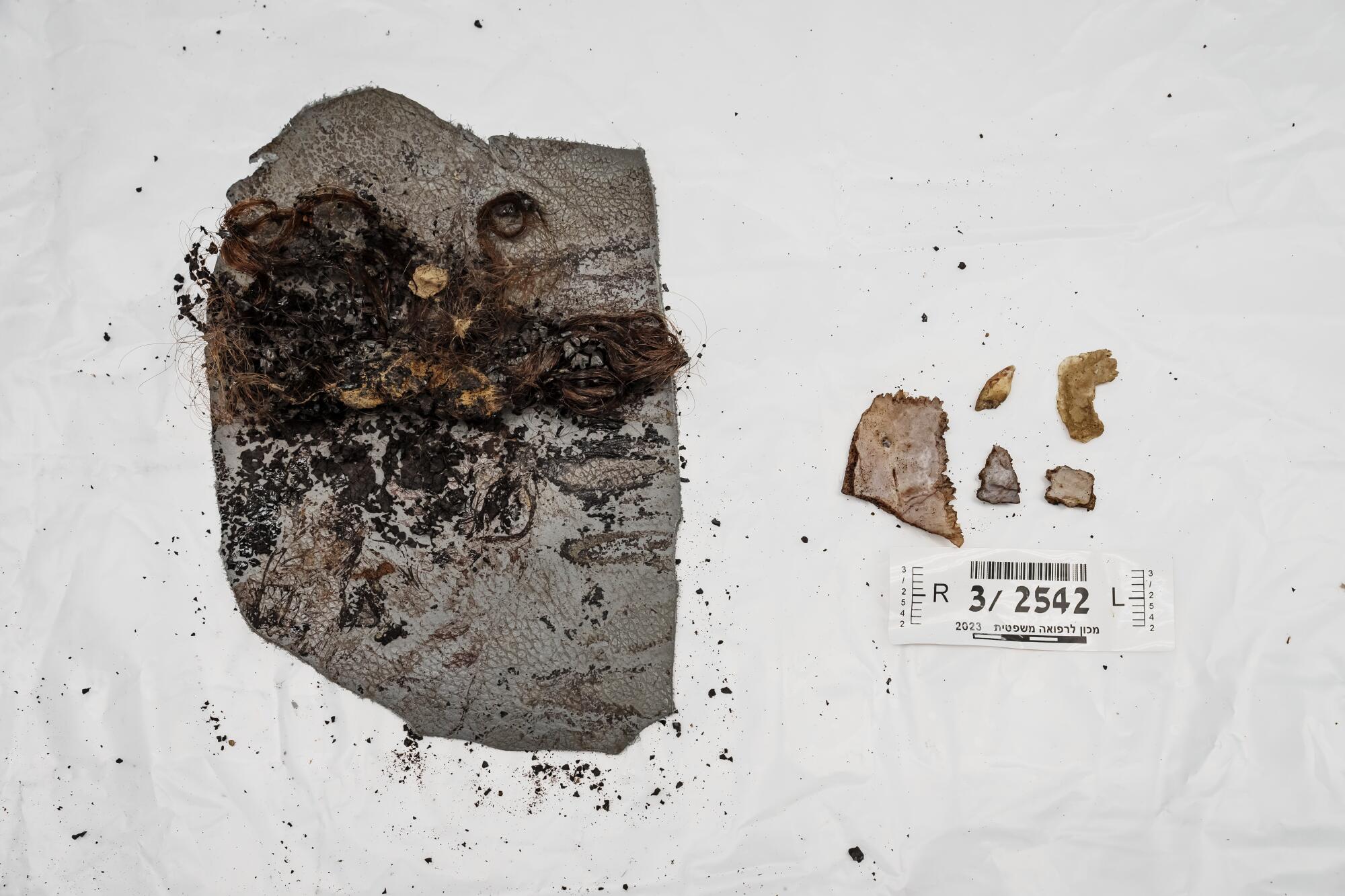
A part of a human cranium and hair hooked up to car upholstery, left, and cranium fragments recovered after Hamas’ Oct. 7 assault in Israel.
The stays got here from cities and kibbutzim close to the Gaza border together with Sderot, Kfar Aza and Beeri — names now recited like whispered hymns — and the musical competition within the Negev desert the place 260 died. They had been collected by Zaka, a workforce of principally Orthodox volunteers, who scoured the panorama so that each doable a part of an individual might be buried in accordance with spiritual legislation.
A blackened tibia got here in a single bag.
“It’s not human,” stated Dr. Alon Krispin, head of radiology on the institute. “It’s a canine.”
A lot of the our bodies had been recognized by DNA, and the employees’s mission now, stated Kugel, a retired commander within the military’s medical identification unit, “is reassembling and reconnecting items.” He was shaken by the fierceness and cruelty that led to the our bodies and CT scans he had seen: “This man has a shattered pelvis,” he stated. “He was shot, stabbed, burned and run over.” He paused. “It is a 12-year-old woman. A decapitation. I don’t know if it was executed earlier than demise or after demise. I believe after, however I can not inform.”


Prime, Tal Simmons, 61, of the Virginia Commonwealth College division of forensic science, far proper, and Israeli medical professionals have a look at a CT scan of charred stays. Backside, Simmons, from left, Sarah Borgel, 33, Helena Gondra, 32, and Ariana Dann, 31, sift by a bag of ashes in search of human stays.
Kugel, 61, spoke of demise as one would possibly converse of equations, permitting him a sure detachment — at the very least on most days. He’s a match man with self-deprecating attraction. His eyes are vivid and deep-set and his voice has a resonance that pulls you shut. He’s a classically educated pianist who performed for years in a jazz band. However he hasn’t sat on the piano — he likes the preparations of George Shearing — in additional than a month. He famous he’s generally overcome by sudden kindnesses.
“One Friday night volunteers introduced meals for Shabbat,” he stated. “I needed to say thanks on behalf of the employees right here. I began to cry as a result of it jogged my memory of humanity, and it reconnected me with the sensation that we’re all individuals and to recollect those who had been murdered for nothing and keep in mind the nice people who look after you and consider you.”
Doorways slid open and closed on the institute, a ragged pale-colored constructing that sits behind a grey gate, testomony to an underfunded and understaffed state company. Odors of chemical compounds and demise threaded cool air. Footsteps had been fast; arms darted out and in of surgical gloves. Vans arrived with new baggage. They had been loaded onto stretchers, their contents scanned earlier than they had been wheeled right into a holding space and brought to analyzing rooms the place they lay beneath white lights, awaiting scalpels, tweezers, saws and devices that might slim the thriller to somebody’s id.

A van arriving from the Shura navy base delivers human stays to the Nationwide Institute of Forensic Drugs in Tel Aviv.
The form of a sinus, a filling, an operation from years in the past. They make the map of the physique, like strains between constellations within the sky. Michal Peer, a forensic anthropologist who grew up in Colorado, the place she labored as an post-mortem intern earlier than shifting to Israel, stood over a desk analyzing bone fragments, ash, cash, items of cellphones. “A tooth,” stated one among her employees, pointing to a scattering of charred bits on a silver tray.
Peer helps determine our bodies whose DNA has been burned away by warmth that surpassed 700 levels Celsius. “Virtually every part I’m getting,” she stated, is burned. “Excessive temperatures. A very long time.”
She turned to a bit of blackened mushy tissue that had hardened over the weeks. She dug for the bone inside.
Hamas militants swept out of the Gaza Strip on the morning of Oct. 7 through the Jewish vacation of Simchat Torah. They fired rockets into cities and pushed east, attacking villages and navy installations. They shot individuals at intersections and bus stops and raided properties the place households tried to cover behind closed doorways. Individuals fled from home to deal with because the militants superior. Many had been shot a number of instances and plenty of had been set alight. Our bodies had been strewn throughout a large terrain. About 240 Israeli hostages had been taken by militants again to Gaza.
Kugel was dwelling that Saturday and acquired a name “a couple of main occasion within the south. I didn’t know the magnitude. I assumed possibly 100 or 150.” The deaths multiplied rapidly, and the institute was too small to deal with the tide of victims. Essentially the most our bodies Kugel had needed to take care of on the institute from a single incident was after a stampede that killed at the very least 45 at an ultra-Orthodox spiritual celebration in 2021 at Mt. Meron.
The Israel Protection Forces on the Shura military base in central Israel took within the our bodies from the Hamas assault. Identification started utilizing clothes, jewellery, enamel, medical data and different gadgets. To hurry up the method and protect the proof, fingerprints and DNA samples had been collected at Shura. Anybody not instantly recognized was despatched to Kugel’s institute.
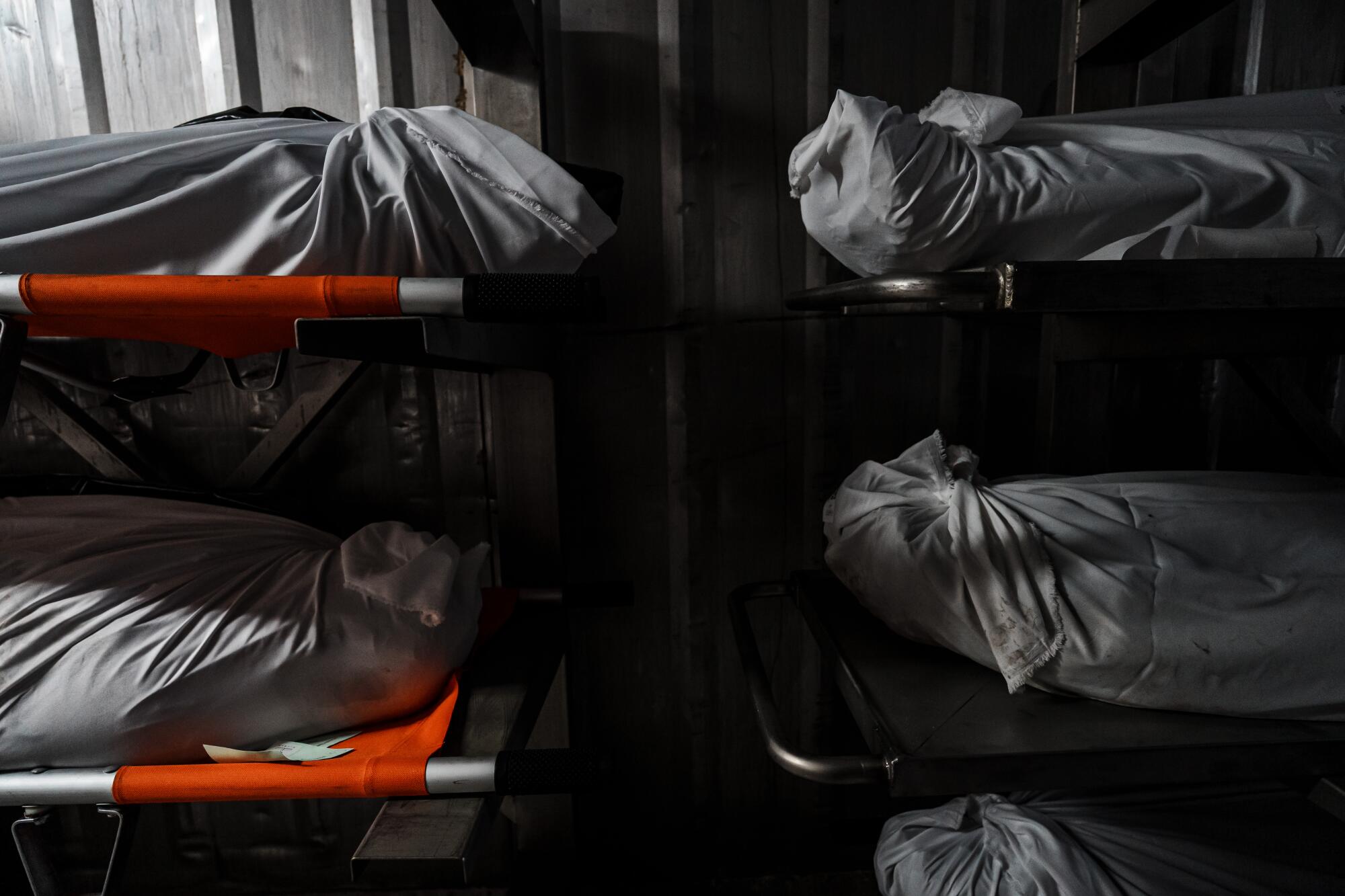
Our bodies recovered after Hamas militants’ Oct. 7, 2023, assault are stored in chilly storage at Israel’s Nationwide Institute of Forensic Drugs.
“Shura was an enormous place with many containers filled with our bodies,” stated Kugel. “It seemed like a port.”
The assault got here at a divisive time in Israel. Protests towards the unconventional right-wing authorities of Prime Minister Benjamin Netanyahu had reverberated for months. The nation was stressed, indignant and off stability. Kugel defined such politics with a joke, saying that Israel isn’t a rustic surrounded by enemies however quite enemies surrounded by a rustic. Nobody sensed — and Israel’s revered intelligence businesses missed — what Hamas was planning and the way it could transfer like lightning and alter a nation’s sense of itself.
“Possibly,” stated Kugel, who, like many Israelis, needs the world to see in grisly element the harm executed, “Hamas wished to make a post-traumatic stress syndrome for this nation. By no means have so many Israelis died in sooner or later. They wished to make us afraid, to really feel insecure.
“However what we noticed,” he continued, “was a rustic reunited. We understood who the true enemy was.”
The exigencies of warfare are many and terrifying, leaving struggling on all sides. Because the physique baggage arrived on the institute, a lot of the worldwide neighborhood was condemning Israel’s relentless bombing in Gaza. Greater than 11,200 Palestinians, most of them ladies and youngsters, had been killed, in accordance with the Hamas-run Well being Ministry. Kugel considered this, the harmless and the perpetrators, which, relying on the facet you’re on, was the story of this bitter and un-reconciled land. However what scared him essentially the most, he stated, was how visceral the Oct. 7 assault was, like a fury within the desert.

“Maybe you had the assumption that sooner or later you would make a compromise for peace,” he stated. “However if you see this you perceive it isn’t the management. It isn’t politics. It’s actual hatred. The [Palestinians] hate us.” The irony, he added, is that “the kibbutzim close to Gaza had been very left-wing and really pro-peace.”
It is going to take a era, he stated, to vary such searing hate. But it surely has been various generations, and Palestinians are nonetheless and not using a promised homeland and Israelis are well-armed but much less protected in a land of excessive partitions and fences.
“We don’t bomb Gaza to show them a lesson,” Kugel stated. “We do it as a result of we discovered our lesson.
“We can not survive like this. Everybody felt the menace to their existence.”
Forty or so migrant staff from Asia had been victims, he stated, together with a person discovered with Sri Lankan cash in his pockets and a Thai laborer practically beheaded with a backyard hoe. “They had been cuffed and shot and I stated, ‘For God’s sake, how are they associated to those issues? Why be so merciless to them? They got here right here to earn cash for his or her households. Possibly you hate Jews, however why do you hate them?’ ”
One other van carrying baggage arrived within the late afternoon. The Zaka males and the troopers had been drained, however they stored to the rhythm and the hours — stretchers rolled and numbers had been recorded. Nir Blatman, who has labored on the institute since 2007, walked previous the van to a delivery container on the rear grounds of the institute. He opened it. A stench curled out like a wave.
“I’ve seen every kind of demise however not on this quantity,” stated Blatman, who at day’s finish would go dwelling and stroll his canine and never suppose a lot about his work. “I attempted to not cry. I’m one of many older ones right here. I wanted to be robust. You could disconnect and work like a robotic. As an alternative of being unhappy, I grew to become indignant. The individuals who had been killed had been scared, they usually knew they had been going to die and that nobody was coming to assist.”
He seemed in and pointed to 4 numbers on a sheet of paper. Hamas militants. They are going to be buried, he stated, in a spot the place enemies go.
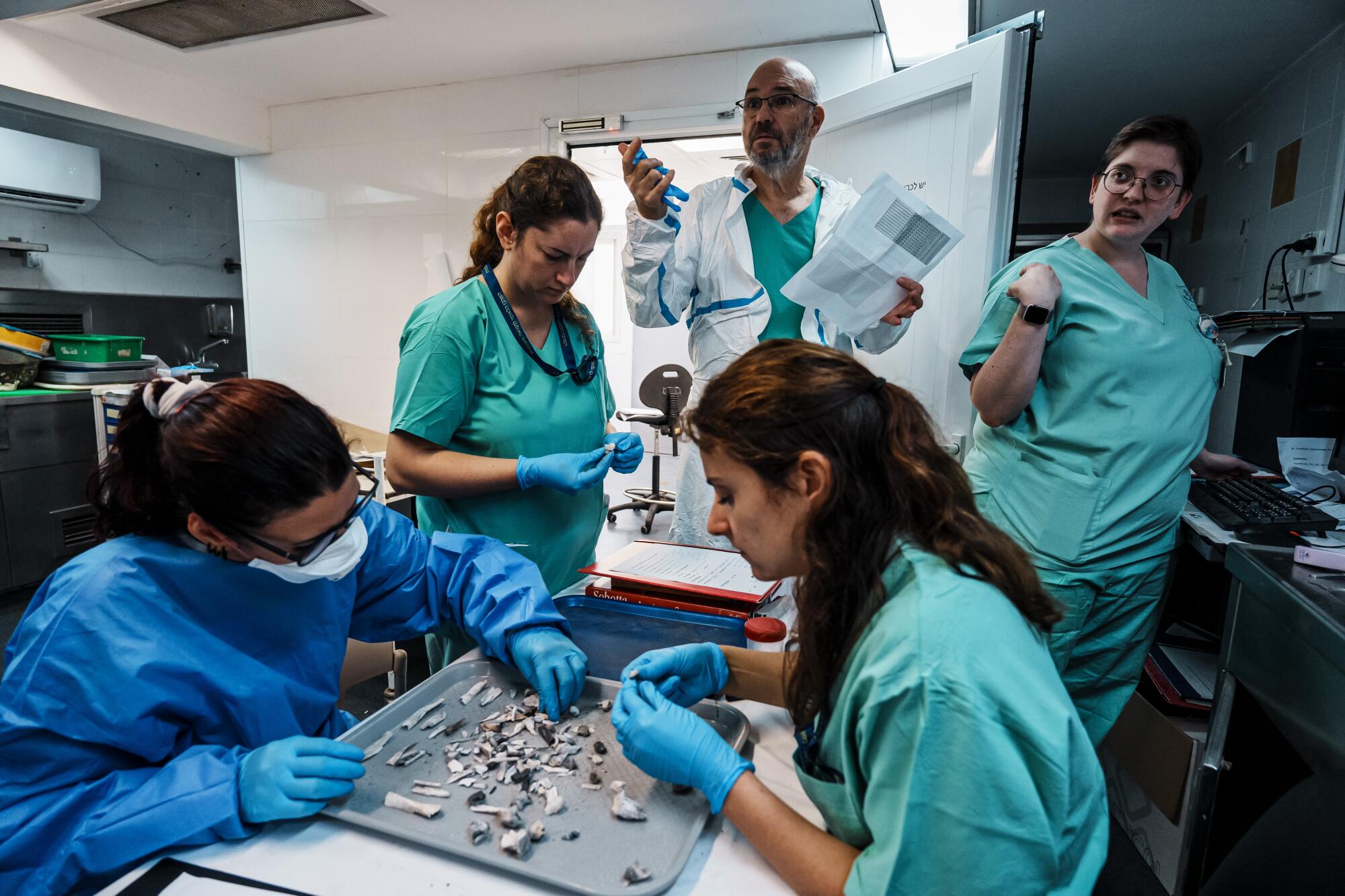
Forensic docs and volunteers study stays on the Nationwide Institute of Forensic Drugs.
Doorways to analyzing rooms opened and closed. As he stood over a blackened foot — it was all that was left of a physique — Dr. Konstantin Zaitsev struggled to take away a coil of shrapnel. He yanked and tugged it free. It shone silver. One other pathologist held up the foot; like a ray of sunshine by a keyhole, the shrapnel had handed throughout. The scrap of a garment subsequent to the foot supplied a clue.
“It’s not an Israeli uniform,” Zaitsev stated. “It’s most likely Hamas.”
Down the corridor, a workforce waited for a van to ship a physique bag that was anticipated to include the stays of a kid. Investigators had earlier discovered a fraction of one among her bones about 100 yards from a home that blew up. A DNA take a look at revealed the woman’s id, however the fragment was tiny sufficient that the kid might be alive (they didn’t consider she was) and lacking, or one of many 240 individuals kidnapped by Hamas.
“She was solely 12 years-old,” stated a physician. “We wish to do all we are able to to complete.”
He paused.
It will by no means be completed. Components would at all times be lacking.
The van arrived. It was not carrying the bag. They must wait till tomorrow.
Endurance right here was demanded, but it surely was a tough factor to know. The hours and vials, so many issues sealed, opened and examined. The way in which a day disappeared. The employees consoled each other with smiles, arms throughout shoulders, shared whispers. Earlier that morning, beneath the tall pines within the courtyard, Kugel thanked them for his or her work and advised them that their lives could be divided into “earlier than and after” Oct. 7. They sang the nationwide anthem and went again to their duties.
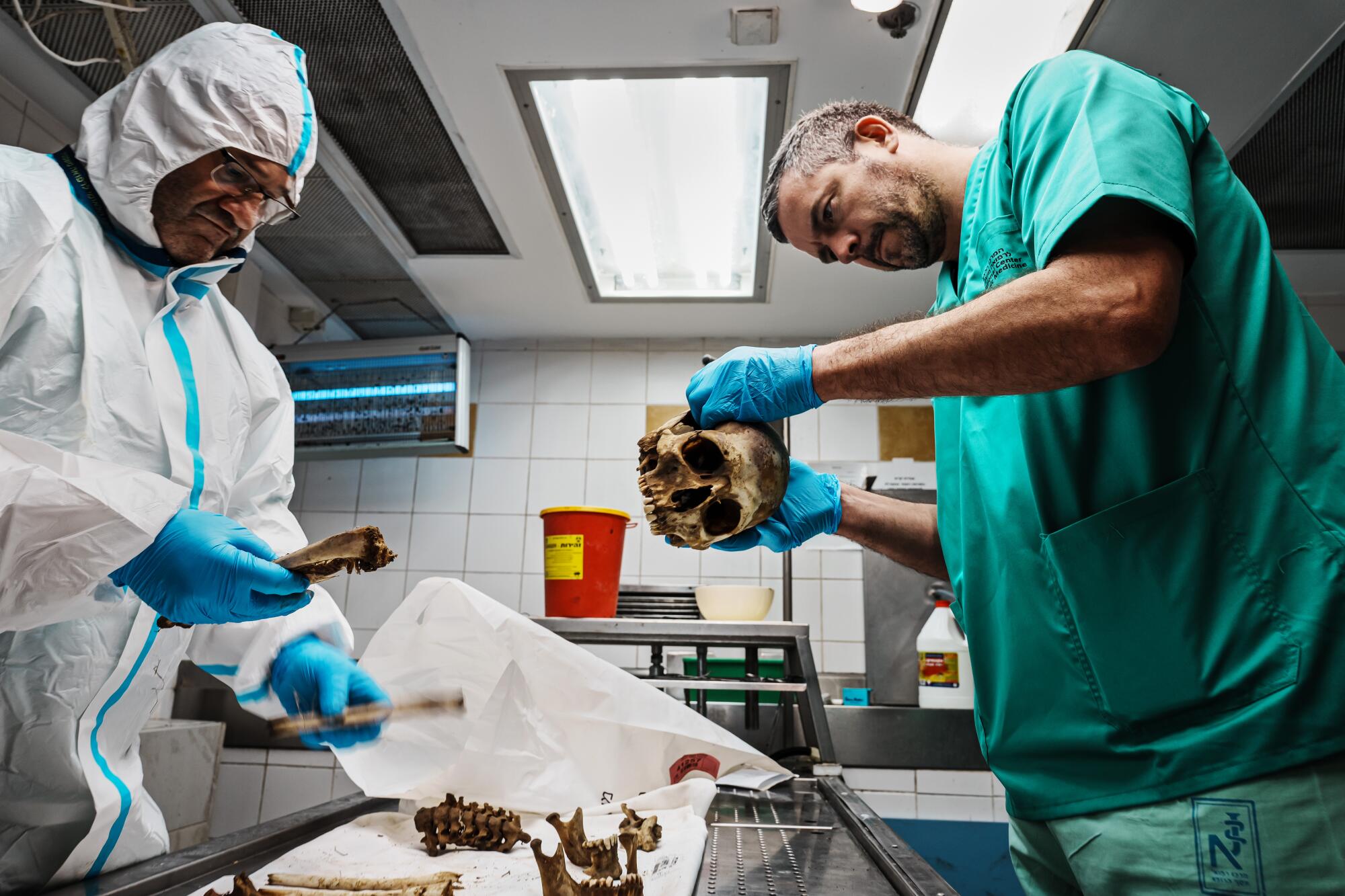
Volunteer Jean Loup Gassend, 41, proper, examines human stays recovered from Israeli communities close to the Gaza Strip border that had been attacked by Hamas militants.
“We had one individual the place we had solely 4 items of his cranium. Very small items,” stated Kugel, holding up the blue tip of a pen. “They had been from completely different elements of the cranium so we concluded that he’s useless. His head was most likely shattered with a high-velocity bullet. That is what’s within the grave. The one factor we discovered of him.”
He stated he didn’t wish to be a person so indifferent that he didn’t really feel. He didn’t suppose he was; a person’s burden, he stated, makes him stronger.
“I don’t wish to brag,” he stated. “However nowhere else on this planet had been so many individuals recognized in such a short while. Even after 9/11 it took longer. It’s simpler right here as a result of everybody should serve within the military. Their blood samples and fingerprints are on file.”
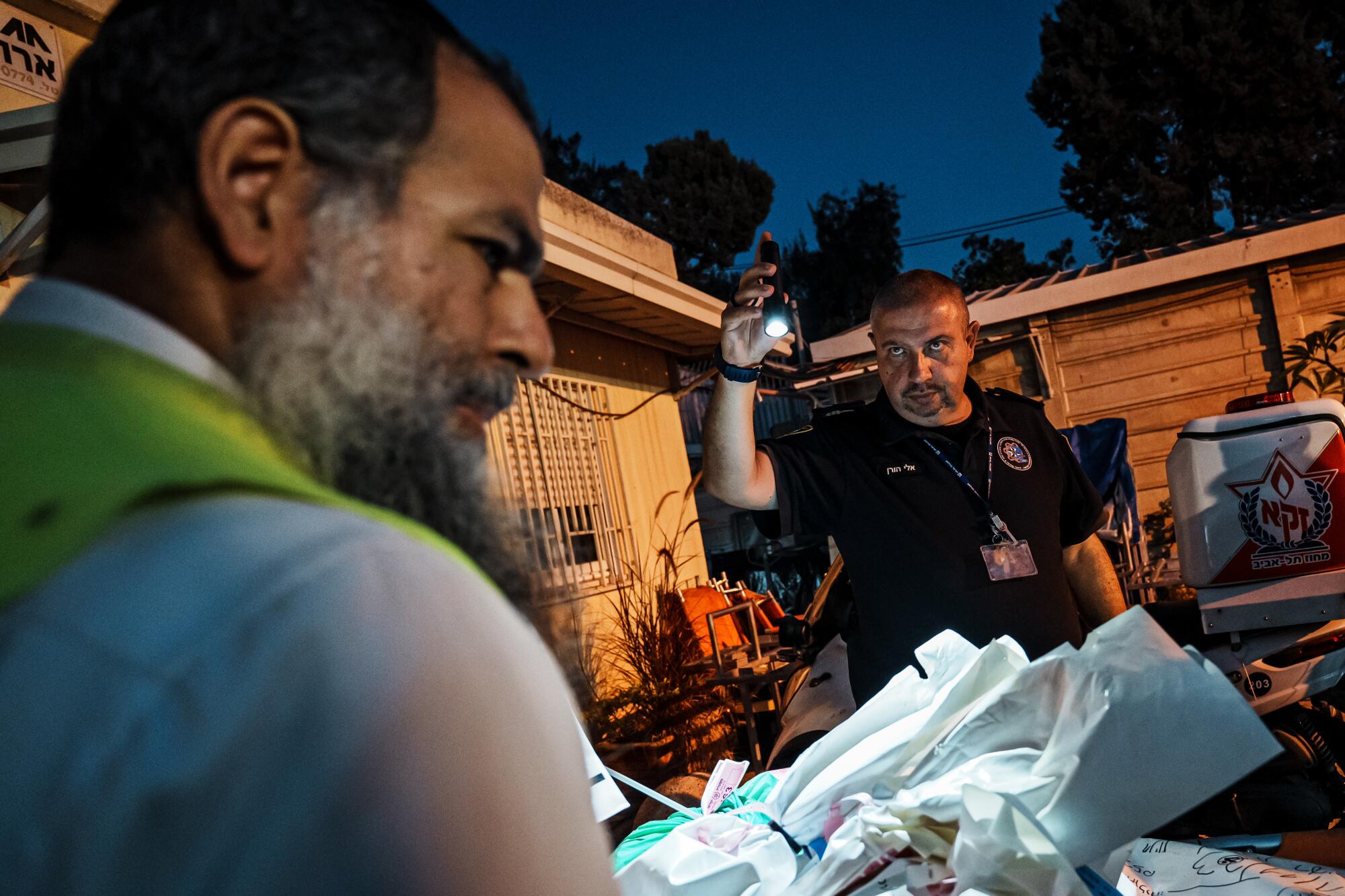
Yohanan Eynee, left, and Eli Horen, a police officer, transfer baggage that arrived from the Shura navy base in Israel.
It grew darkish. A number of the employees modified out of their scrubs and into road garments. A physique was slid right into a cooler. A pathologist rode her bike towards the gate. A safety guard watched her glide beneath the bushes. Just a few staff sat within the stillness of the courtyard. Mushy music performed. The vans had been executed coming for the night time. However there could be extra baggage tomorrow.
#Israeli #lab #reassembling #stays #killed #Oct
